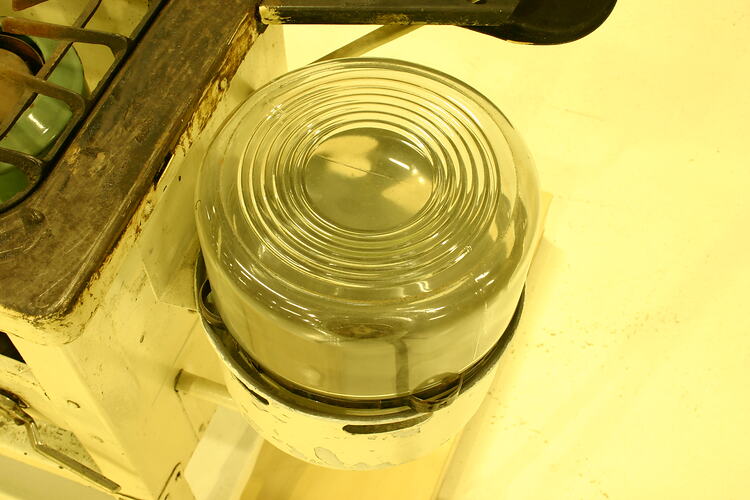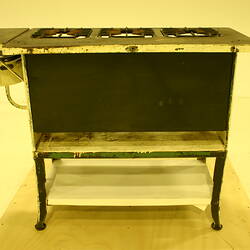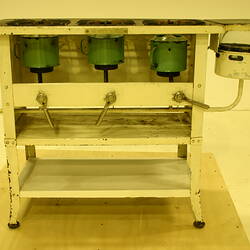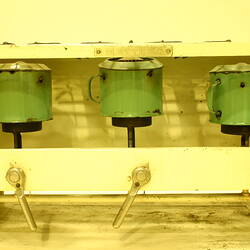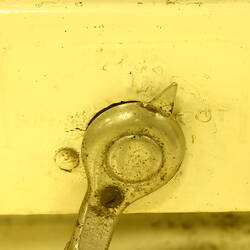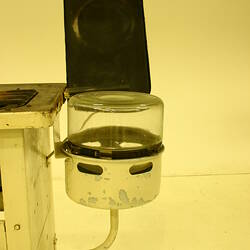Summary
Metters' kerosene stove, comprising three burners above two open shelves. It was made in Subiaco, Western Australia. A 1931 advertisement shows the stove with a back panel above the burners. It was touted as offering 'Economy, Simplicity, Reliability, and Absolute Safety' (Advertiser and Register (Adelaide, SA, 20 March 1931, p. 24).
The stove was used in St Albans, Victoria. The donor's mother purchased the stove second hand from Victoria Markets in 1952. It was used in the garage in which they lived whilst their house in St Albans was being built. The donor's mother stopped using the stove soon after the introduction of electricity to St Albans in 1953. Kerosene was an essential fuel during the pre-gas and pre-electricity age. It was cheap, accessible and commonly used for many different appliances. After the introduction of gas and electricity kerosene appliances were also used to supplement existing fuels, especially during power strikes or other interferences.
Physical Description
A kerosene stove, with three burners and open storage underneath. The unit sits on four legs, with pinched circular feet rests, TOP: 3 burners, removable grill, with rounded square plates, set into a solid blackened enamel top. At right, enamel shelf from which hangs kerosene supply. FRONT: Metal disk applied centre top. 3 burners, green enamel, attached to horizontal pipe leading to kerosene supply at right. Below each burner, silver metal controls: long handles with flat circular bodies and arrow point. Below burners 2 solid metal trays, top one in cream enamel, lower one covered with white contact. Indistinct moulding on top tray front left and front right. SIDES: Right: kerosene unit. Circular glass bowl sitting in cream painted metal base with pipe (for feeding burners) at centre of base. Metal shelf above, hinged at back to provide access/ cover. Left: pipe from front feeds through side, attached to a vertical pipe. Top of vertical pipe covered with foil. End of horizontal pipe bolted shut. BACK: black panel.
Significance
Kerosene stoves demonstrate the changing power sources within the home, the migration of technology and cultures to Australia in the post-war years, and the changing design of kitchens and cooking equipment. The donor's mother stopped using the stove soon after the introduction of electricity to St Albans in 1953. When the donor's family migrated to Australia they lived in a garage while their house was being built. Kerosene was an essential fuel during the pre-gas and pre-electricity age. It was cheap, accessible and commonly used for many different appliances. After the introduction of gas and electricity kerosene appliances were also used to supplement existing fuels, especially during power strikes or other interferences.
More Information
-
Collecting Areas
-
Acquisition Information
Donation from Mrs Maryanne Grover, Mr John Grover, 25 Nov 1993
-
Manufacturer
-
Inscriptions
FRONT: on metal disk "METTERS". Moulded around controls "LIGHT BURN OUT". Top tray moulded front right "THE STOVE WITH / THE ? WICK".
-
Brand Names
-
Classification
-
Category
-
Discipline
-
Type of item
-
Overall Dimensions
109 cm (Length), 44 cm (Width), 80 cm (Height), 28 cm (Outside Diameter)
-
References
Advertising (1931, March 20). Advertiser and Register (Adelaide, SA : 1931), p. 24. Retrieved November 7, 2016, from [Link 1]
-
Keywords
